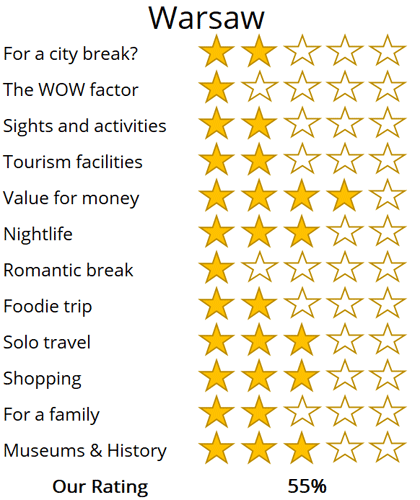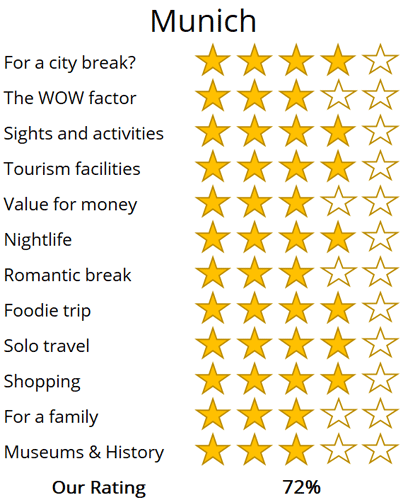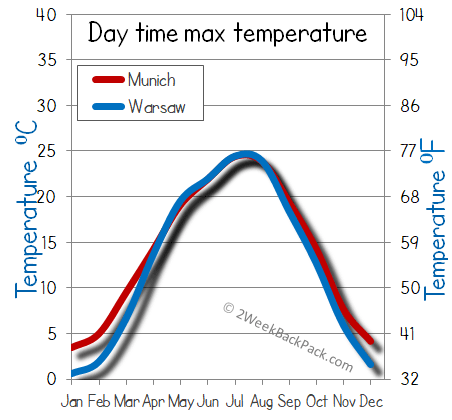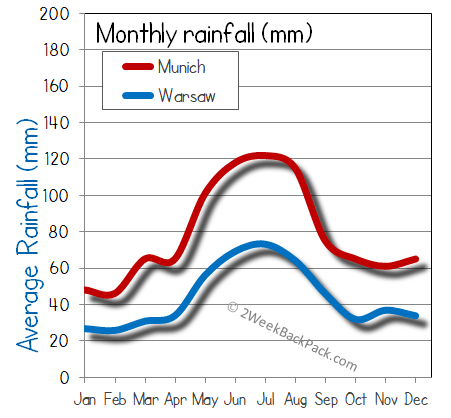WhereToGoForMyHoliday.com
The best destination comparison site!
WhereToGoForMyHoliday.com
The best destination comparison site!
Warsaw or Munich, which is better for your holiday in 2024?
Warsaw and Munich both offer unique and enticing experiences, but which one should you choose for your city break or holiday?
We recognise the difficulty in making this decision. While there is abundant information available on both destinations, clear guidance on which city better aligns with your travel preferences is often hard to find.
This article aims to provide an impartial comparison of Munich and Warsaw, and hopefully help you to choose the best city to visit.
The article is structured into several sections, each of which can be directly accessed through the following links:
• Introduction to the cities
• Scores and ratings
• Which one should I, friends, or family visit?
• When to visit and weather
• Who is the city suited for?
• The perfect 48hours (with map)
• Tourism details (where to stay? airport details?)
Introduction to Warsaw and Munich
Warsaw is a vibrant city that seamlessly blends the old with the new, offering a mix of historical sites and modern attractions.
This Polish capital is a city of contrasts. On one hand, you have futuristic shopping centres, and on the other, a Soviet-era skyscraper dominating the skyline. The Old Town, with its medieval appearance, is actually a meticulous reconstruction post-World War II.
It's this variety that makes Warsaw so intriguing. Whether you’re taking a romantic stroll through Łazienki Park, learning about the anti-Nazi uprisings, admiring Polish art in national galleries, or exploring the trendy Mokotow district, there’s always something new to discover.
Beer-mad and shrouded by the mountains, Munich is the boisterous capital of Bavaria. It's in the deep southern reaches of the country, where lederhosen are the threads of choice and white sausage is served at breakfast. Proudly unique, romantic, and steeped in art and culture, you won't find anywhere else like this in Germany.
Of course, it's the legendary Oktoberfest that puts Munich on the map. One of the world's biggest festivals, it draws millions to the city in late September (yes, Oktoberfest is confusingly held in September) to glug huge beers and eat endless wurst. Trips at any other time of the year are sure to be a little more refined. They can involve long walks under Baroque churches, picnics in the English Garden park, and even daytrips to the stunning Bavarian Alps.
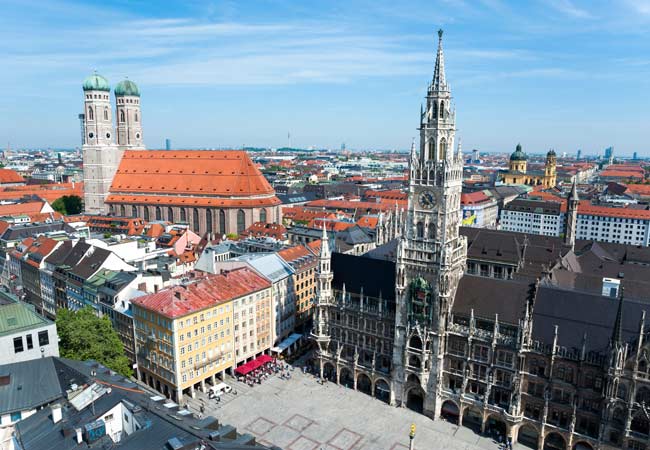
The Marienplatz and the historic centre of Munich, with the Frauenkirche Cathedral, and Neues Rathaus

The historic centre of Warsaw
High-level summary for Warsaw and Munich
Summary
Where would I journey for a personal escape?
Munich
Where would I send my parents for a memorable visit?
Munich
Where's the ideal destination for my adventurous 19-year-old cousin?
Munich
Where should my food-obsessed friend indulge their culinary passions?
Munich
Note: The above comparisons are weather-independent and are based on travel during the most opportune times of the year. Details about the ideal travel seasons are elaborated upon later in this article.
In the sections that follow, you'll find a comprehensive comparison between these two fascinating cities. This includes recommendations on the duration of stay, the best times to visit, and tailored 48-hour itineraries for each city.
The final segment delves into practicalities for your travels, such as the best airport to fly into, the optimal districts for your accommodation, and insider tips, for when you come to explore the city.
We hope that you find all of this information useful, in planning your next exciting trip!
Destination details
How long to spend each city?
Take a couple of days minimum to get a feel for the alternative vibes of Munich. You'll need at least a morning or two to check off the grand churches and plazas of the downtown. Afternoons are often lost to a haze of currywurst and spätzle. The evenings will disappear to clinking tankards and too much Bavarian beer.
If you're planning on joining the Oktoberfest party, then the normal amount of time to spend in the Munich event is two days. Some people will stick around longer but remember that accommodation can cost a bomb during festival dates and you'll need to book well in advance.
The closeness of the Alps and the wide variety of off-the-beaten-path neighborhoods in Munich mean that it's also possible to stay here for much longer than just a weekend or a couple of days. You could do weeks of hiking in the spring and summer months. Alternatively, you could do a full ski holiday in nearby Garmisch-Partenkirchen (Germany's biggest resort) during the winter.
Warsaw can be done quickly. Just a couple days is all you'll need to see the Old Town, the Palace of Culture and Science, the grand parks, and the main museums.
Of course, if you've got extra time to spare, Warsaw will always be able to fill it. Once you've checked off the main attractions, there are stacks of more local sights, eateries, and activities to get stuck into. They include café hopping down in hipster Mokotow, tasting ethnic foods in multicultural Praga, and even day outings to the Kampinos Forest or the post-industrial city of Łódź.

Excessive amounts of beer, lederhosen, singing and crazy fairground rides… it can only be Oktoberfest

The Park Royal Baths Park (Łazienki Królewskie) is the largest park in Warsaw and a great location for a summers day
Munich is one of those cities that has something going for it no matter the time of the year. Lots of people like the height of the summer, for the regular sun and temperatures that often spike above 30 degrees in the middle of the day. That's certainly perfect for wandering the town and enjoying the big lawns and paths of English Garden.
The autumn is best known for Oktoberfest. The shindig and the beer drinking begin in mid-September, lasting until the first couple of days in October. It's usually still warm for the party, but the days get shorter and jumpers will be needed as you get closer to November.
There's often snow in Munich from December onwards. This is the time of year to come if you have your sights set on the ski fields of the German Alps. The slopes of Garmisch-Partenkirchen typically open for business before Christmas, which is also when the enchanting markets start selling gingerbread and sausages on Munich's medieval squares.
Spring is also lovely. May is among the best months of all to travel. The summer crowds haven't arrived yet, the snows have melted, and thermometers can read a pleasant 20 degrees during the day.
If you don't want to wrap yourself up in cotton wool and thermals every time you step outside, it might be best to avoid the winter months in Warsaw. From November to December, below-zero temperatures are normal in the Polish capital, along with icy rain, sleet and snow.
Most locals often say that spring and early autumn are the sweet spots. While summer's warm, it can often be humid, and there's no beach or ocean nearby to help you cool off. Months like April and May see milder days and cool nights, while September is prime time to wander the famous parks of Warsaw, as the trees begin to change colour and glow orange, ochre and yellow.
Warsaw captivates those who appreciate lively, bustling capital cities. While the Old Town is stunning, it's not the main attraction. Instead, expect to spend your time exploring vibrant and authentic neighborhoods, filled with a variety of dining options from fusion to fine dining. Discover craft beer on guided tours and enjoy artisan breakfasts in quirky cafes.
On the other hand, Warsaw offers a deeply immersive historical experience. The Warsaw Uprising Museum and the POLIN exhibitions provide insightful introductions to the challenges faced by the Polish people and Polish Jews during Nazi occupation. Don't miss the 800,000 exhibits at the renowned National Museum, and take time to explore grand parks, complete with Chinese gardens and monuments dedicated to Chopin.
Munich is unique in that it manages to fuse together the great outdoors, rich European culture, and an enticing foodie scene. That's all thanks to its place as the historic capital of Bavaria, which brings a long tradition of cooking, beer making, castle building – the list goes on.
The upshot? There are all sorts of travellers who are catered to, no matter if you come in search of pretzel eating or high-altitude trekking.
One thing you won't find in this city is the sea. The nearest saltwater is a hefty drive over the Alps in Italy or Croatia. So, don't come if you're pining to top up the tan and swim in the Med.

The gothic Saint Florian's Cathedral in Warsaw

The Englischer Garten (English Garden) is the spawning park in the centre of the Munich
48hours in Munich
Sample Munich's famous food, beer, and regal inner city on this two-day itinerary that's packed with amazing palaces and parks. If you're hanging around for longer, then you should also have time to make a beeline for the Alps or explore those off-the-beaten-track neighborhoods, but that will have to wait…
Day 1: Your travels begin on the grand Odeonsplatz. A prime example of the city's 19th-century rebuilding, it hosts some of the most magnificent sights in the region. There's the huge, 130-room Munich Residenz, the onetime home of the Bavarian kings and queens. There's the Theatine Church from the 1600s, sporting its dual Baroque towers.
You only have 48 hours, but the palaces can be visited if you have extra time. Instead, move on through the heart of the city on Briennerstraße to the vast plaza of Königsplatz. This is a photo op extraordinaire, with handsome Neo-Classical monuments like the strange Propyläen. The area around that is the artistic quarter (the Kunstareal), where there are endless museums and galleries to go into if you need to warm up or escape the rain.
Next is the beautiful Frauenkirche. This is a symbol of Munich as a whole; a great church topped by bulbous domes on the central Frauenplatz. It will take around 20 minutes to walk over there, but you'll enjoy moving into the Altstadt area as you go. You should plan to spend the evening within, hopping between sights like the iconic Hofbräuhaus (the best known beer hall in the city) and the ancient Peterskirche (the oldest church in Munich).

The Schloss Nymphenburg and its beautiful grounds
Day 2: No visit to the grand royal capital of Bavaria could possibly be complete without at least a glimpse of the Schloss Nymphenburg. It's hardly central, but private tours can whisk you there and back in a single morning, going through the manicured gardens, the court rooms, and the curious Marstallmuseum with its gold-leafed carriages from the 19th century.
When you return back to the middle of Munich head straight for the English Garden. This is one of Germany's favourite parks. You could start by strolling up the Eisbach to see the surfers riding the river wave. Then explore the pretty Hofgarten, where babbling fountains and bandstands once provided a retreat for Bavarian royals. Alternatively, go straight to the Chinese Tower Beer Garden, to glug traditional German hops brews and taste bratwurst and pretzels until sundown.

The Olympiapark complex, constructed fro the 1972 Olympics
48hours in Warsaw
This perfect first 48 hours offers a fun-filled and exciting introduction to life in the Polish capital. It's a cocktail of wartime history, art, and – of course – good old Slavic beer.
Day 1: Hit the Old Town of Warsaw as early as you can. That way, you'll avoid the crowds, and – on a sunny day – get to catch the gilded medieval-style frontispieces in some perfect photography light. You certainly won't want to miss a moment on grand Plac Zamkowy (Castle Square).
The Royal Castle that gives it the name is the star of the show, with its orange-tinged exteriors and Baroque domes. It, like the whole rest of the Old Town, is actually deceptively new. The entire district had to be rebuilt from ruins in the wake of WWII.
Wait for the folk from the Free Walking Tour under Zygmunt's Column. Their two-hour odyssey through this part of the capital really digs down into the unique mosaic of architecture. After that's done, you can hit Nowy Swiat and follow the route Polish monarchs once took in and out of the city. It's now a buzzing modern thoroughfare with dumpling taverns and beer halls (perfect for lunch).
Follow it all the way south and hop a few more blocks and you'll soon be in Łazienki Park. It's an icon of the metropolis. An evening stroll here could start with a vision of the huge Chopin statue and end with a sighting of the Classicist Temple of Diana. For dinner, where better than hipster Mokotow? The district has everything from Tex-Mex to stylish sushi bars.

The Warsaw Barbican (barbakan warszawski) dates from 1540, and was part of the fortifications that encircle the city
Day 2: A selfie stop outside of the iconic Palace of Culture and Science starts day two with a bout of Soviet architecture. A 237-metre spire of a building, it was a personal gift to Poland by one Joseph Stalin. From there, a few trams stops can whisk you over to the Warsaw Uprising Museum. The enthralling exhibits of that showcase the heroic efforts of Poland's underground resistance during the fight against the Nazis.
Afterwards, make straight for the riverside and the leafy Vistula Boulevards. They're a hubbub of life in the summer months. Dog walkers meet buskers and street entertainers right by the water. (An optional drop into the family-friendly Copernicus Science Centre is a great addition if the rain's a-pouring). For the evening, hip and elegant Praga awaits. That's arguably Warsaw's most stylish area, with Lebanese kitchens giving way to bohemian bars and cool coffee shops.

The striking Palace of Culture, standing at 237m is the tallest building in Poland
Public transport in Warsaw means trams and buses. The network of more than 260 combined lines can take you virtually anywhere you want to go.
What's more – it's cheap! Just 3,4 PLN can get you from A to B on any route, but there are also 24- and 72-hour tickets that won't break the bank. You can get them at machines located at the stops, or in any kiosk dotted around town.

Saint Alexander’s Church was constructed in honour of the Russian tsar Alexander I
Warsaw has two international airports. There's the larger Warsaw Frederic Chopin Airport, which can be reached by direct train from Warsaw's main station on line S2 or S3. The smaller Warsaw Modlin International Airport is a hub for European low-cost carriers. To go from terminal to city from there, you can ride the private Modlinbus, or catch the loop train that goes to both airports and then Warszawa Centralna.
A big Polish presence and a welcoming local vibe means there's rarely trouble for tourists in WarsawPickpockets, angry bouncers in clubs, and the classic European taxi scammers are the most common frustrations beyond that. .
When it comes to picking a hotel, it's typically best to be on the western side of the Vistula River. Some of the very best accommodation choices hide amid the cobbled lanes and squares of the Old Town. Others sit within walking distance, by Mirow or the Palace of Culture and Science. Being on the far side of the river means finding some cool aparthotels in local's favourite Praga.
Munich International Airport is the second busiest hub in all of Germany. It's a major arrival point, with links coming in on premium and low-cost fliers from right around the globe. Getting to the city from the terminals is easy thanks to the direct S-Bahn line that runs straight to the train station. The trip costs just over €11 and takes around 40 minutes in total.
Long-distance overnight trains and local German trains alike will arrive at Munich Central Station. It's right in the heart of the city, within walking distance of the Altstadt and the Odeonsplatz. If you'd prefer not to walk to the door of your hotel, however, you can enter the S-Bahn or U-Bahn networks from there. Those, along with the comprehensive bus routes and tram lines, can get you virtually anywhere in the town. Basic one-way single tickets cost €2.80 per ride. Buy them at the blue vending machines located in the stations.
Munich is a safe, modern city. The locals are famed for their friendliness and welcoming attitude – a trait of Bavaria, they say. However, it's still important to be wary of scams and dangers, particularly during the Oktoberfest, when alcohol intake increases dramatically.
The best areas to stay in Munich are the Altstadt, the streets around English Garden, and the grand university and gallery area of Maxvorstadt. Cheaper hotels that are still within walking distance of the sights can be found south of the main train station around Bayerstraße.

The Odeonsplatz plaza and the distinctive yellow Theatine Church
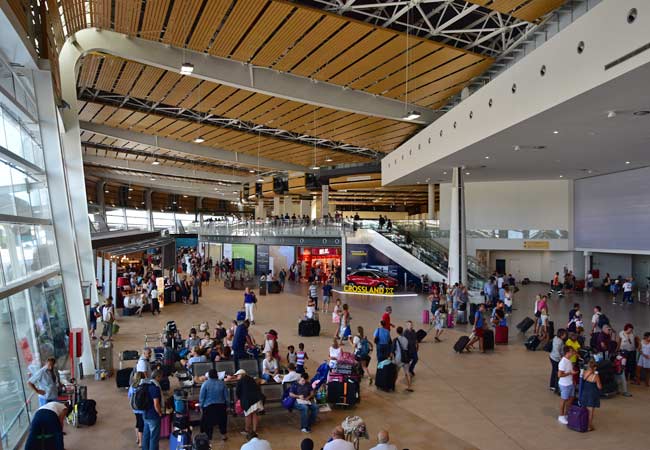
oh we were stuck in the airport!

Copenhagen was a bit expensive...

All we did was drink beer in Brussels...

Muncih was crazy

And we got so burnt!
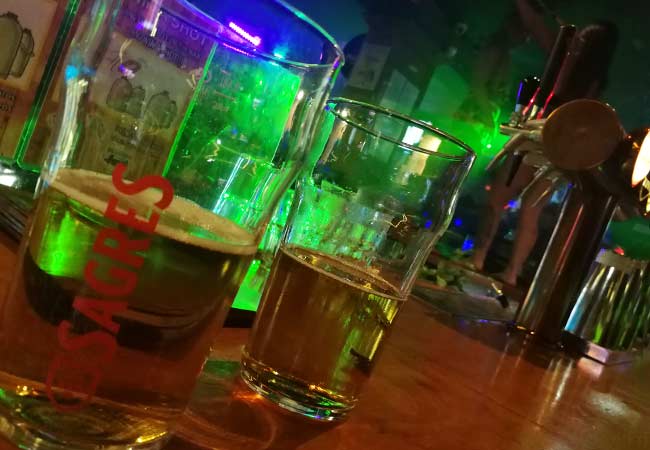
Remeber that night in Rome

oh we were stuck in the airport
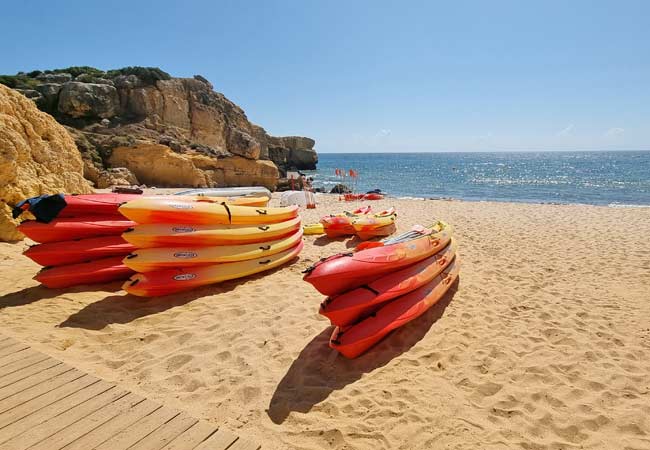
So much fun kayaking

Berlin and that group from Austria!

There was such a view from that church

And we got so burnt!

Munich was eventful, wasn't it!

Such a view from that cathedral in Florence
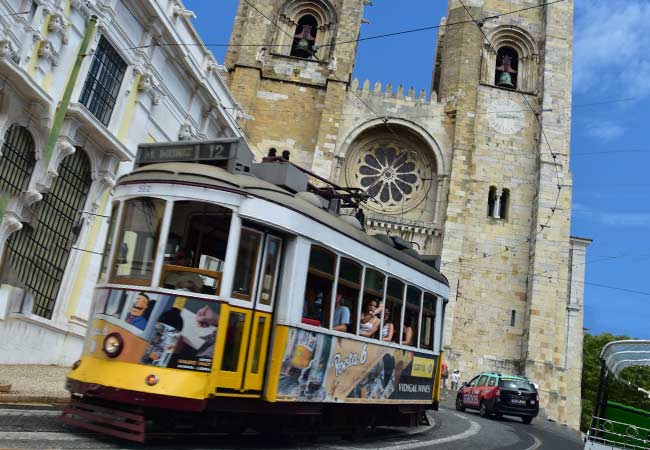
Lisbon was such so much fun

Last summer was so much fun .... x

Remeber that night in Rome

Lisbon was such so much fun

Such a view from that cathedral in Florence

Munich was eventful, wasn't it!

And we got so burnt!

Remeber that night in Rome

All we did was drink beer in Brussels...

Berlin and that group from Austria!

Can't wait to go back to Dubrovnik

Remember that boat ride in Prague

Copenhagen was a bit expensive...
